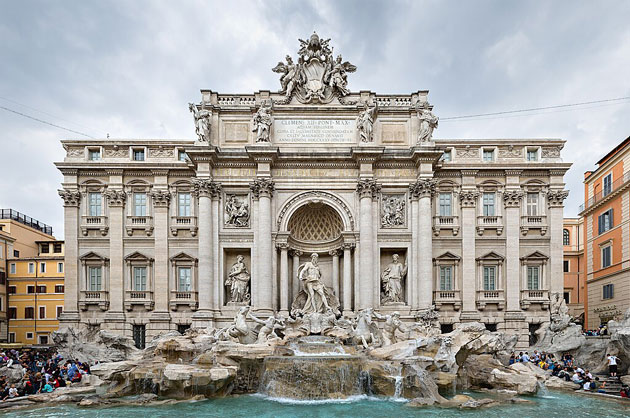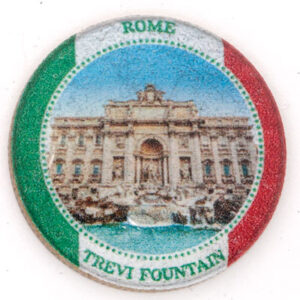Everything You Need to Know about Tossing a Coin into Rome’s Trevi Fountain
Last updated:One of Rome’s most iconic tourist attractions is filled with rich history…and coins? The Trevi Fountain is located in the heart of Rome where three streets meet, hence the name Tre (meaning three in Italian)!

The Fountain
The stunning monument was built of marble between 1773 and 1762 and originally designed by Nicola Salvi. The meaning behind the fountain was to represent the taming of water which is showcased with sculpture of Oceanus (Focal point of the fountain), also featuring Abundance (to the left), Health (to the right), Abundance of Fruit, Fertility of Crops, Products of Autumn, and the Joy of the Gardens. While the sculptures remain the same, the water system has since been upgraded to use recycled water. It produces roughly 2,823,800 cubic feet of water every 24 hours.
The Tradition
The 1950’s Academy Award-Winning American film Three Coins in the Fountain brought attention to the iconic attraction and started a worldwide practice all at once. Local lore has it if you toss a coin into the fountain with your right hand over your left shoulder to pass over your heart, you’ll be brought back to Rome. If you throw two coins in, you might end up living in Rome. Or if you’re really dedicated, three coins is supposed to find you love or marriage right there in the Eternal City. While some interpretations of what you’ll get for each coin toss vary, the locals all agree that each coin needs to be thrown in separately for the wishes to come true!
The Coins
The Trevi Fountain is one of Rome’s largest attractions. Assuming every tourist that visits is at least making one wish, one must wonder – just how many coins land at the bottom of the fountain? On average, about 55 tons worth of coins are tossed in annually – about half the weight of a Blue Whale. It is estimated that 3,000 Euros are tossed in a day, which is about $3,600 USD. This means the Trevi Fountain takes in about 1,250,000 Euros annually – adding up to $1,500,000 USD each year!
As soon as a coin lands in the bottom of the fountain it becomes city property – which means taking it is legally considered theft. In the past there were issues with people jumping in to collect the coins! With the now heavily enforced law in place, even dipping a toe in the fountain is highly forbidden. Trying means you will be greeted by police and a hefty $500 fine. There is heavy police presence when the coins are collected by an authorized official. Using steel brush poles, coins are gathered into a large pile and then they are suctioned up through a hose. The coins are cleaned, weighed and passed on to their new home.
The Charity
Once the coins have been accounted for, the funds go to Carita, a nonprofit Catholic organization. The money from the Trevi Fountain makes up about 15% of their annual budget. All of these funds are used to provide aid to soup kitchens, homeless shelters, free markets and additional outreach projects that help the residents of Rome living in poverty.
My Experience
In 2018, I traveled to Italy with 18 of my family members! We stayed in Rome for a couple of days and in that time, we went to the Trevi Fountain. Unbeknownst to me, just a few short weeks after I tossed my Euro into the famous water, I would start dating a fine fella. Five years later, I can tell you that the legends of finding love are true in my case as we are now happily married!
Bring Rome to your Home

Bring a piece of Rome to your collection when you join our Ancient Roman Coin Club here! You’ll enjoy monthly shipments of ancient coins, and build an amazing “portrait gallery” of the legendary emperors who ruled Rome. You get each month’s selection before you buy and you only keep the coins you want! Plus, there is no obligation to purchase any selection and you can cancel this service at any time. If you had just one wish – what would it be? Share it with us in the comments!
This article was written by Susan A.
Susan A. graduated summa cum laude with a Bachelor of Arts degree in English in 2021 after an abbreviated college experience split between Plymouth State University and the University of New Hampshire. She is an eight-time self-published author and social media content creator.




